Smoke Whisperer
A gasification system for
sustainable living
Carbon-neutral heat, hot water
air/water purification,
electricity, and fuel

Using a converted “skoolie” school bus as a canvas, the Smoke Whisperer explores how a single technology, biofuel gasification, can be adapted to meet a wide range of modern needs without relying on fossil fuels, mineral extraction, or excessive global trade.
By using biofuels and effectively processing the residual activated biochar, we can both reduce our carbon emission and actively sequester carbon from the atmosphere. The process involves utilizing on-vehicle exhaust filtration and co-composting the activated biochar into agriculturally rich soil.
This project is a modern exploration of shelter, however many of the technologies can be repurposed for other community-scale applications; from local power generation, to water filtration and soil enrichment. Everything about the project, including final designs, will remain free and open source, so that anyone may use, reuse, adapt and improve them as needed. The aim here is to promote a community of exchange around ideas that help those same communities become prosperous, locally self-sufficient, and environmentally sustainable.
Continued development of the Smoke Whisperer project would not be possible without the help of multiple partners. Special thanks to Austin Liu who has advised on biochar and gasification principles, and to several Portland-area makerspaces who have provided fabrication resources for developing a prototype, including Hedron Hackerspace, creators at the Manifestation arts building, and Past Lives Makerspace.
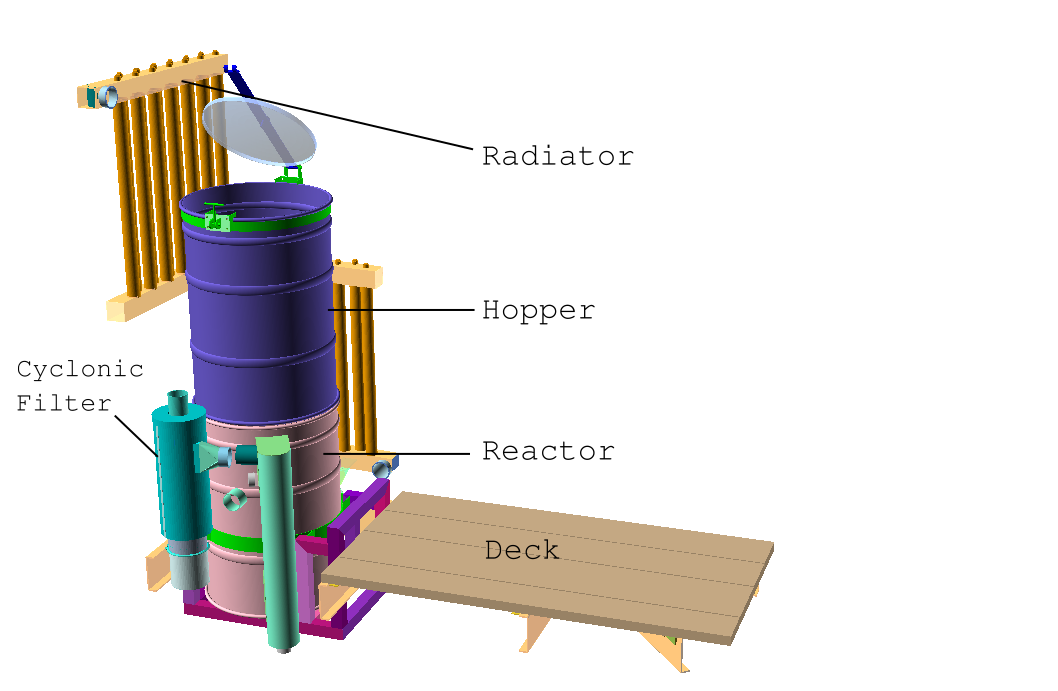
Gasification... read more
The gasifier is the core of the Smoke Whisperer system. It can power an engine, generate electricity, and radiate salvageable waste heat. It works by partially combusting biomass in an environment of restricted oxygen and extremely high temperatures. The resulting gas can then be used directly as a fuel.
The process of gasification involves preheating, pyrolysis, combustion, reduction, heat transfer, and filtration. The process is physically complex but technologically simple. The technology has existed for over a century, however it has been largely neglected due to the ease, affordability, and power density of fossil fuels.
You can learn more about gasification through these resources:
-
Drive on Wood – a lively DIY community of automotive gasification enthusiasts
-
All Power Labs – a CA-based company specializing in stationary gasification and activated biochar

[reactor and hopper internal components]
Activated Biochar... read more
Activated biochar is a byproduct of gasification. Its applications and benefits are an area of active research. Producing quality biochar involves balancing biochar yield against gasification combustion efficiency.
Like ordinary biochar, activated biochar can be used for a wide range of applications such as water filtration, improving soil aeration, reducing soil greenhouse gas emissions, reducing soil acidity, and improving soil nutrient retention. However, unlike ordinary biochar, activated biochar is produced at higher temperatures (800-1400C or ~ 1500-2200F), giving it a larger, micro-porous surface area closer to that of activated charcoal. These characteristics allow it to perform with improved adsorption, microbial activity, nutrient retention, and water-holding capacity, making it an ideal resource for water filtration, soil enrichment, and carbon sequestration.
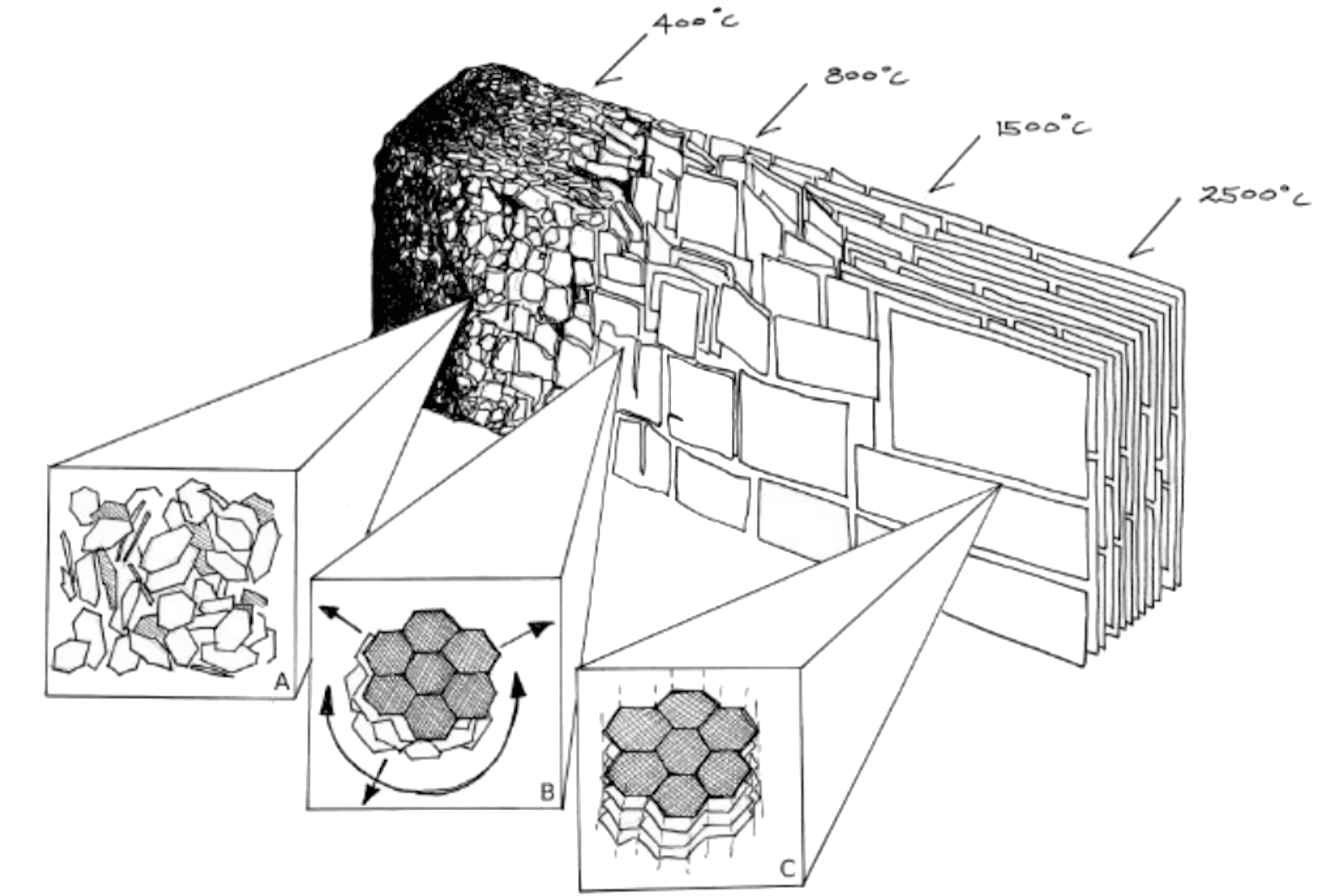
Ideal biochar structure development with highest treatment temperature.
[Are, Kayode. (2019). Biochar and Soil Physical Health. Kayode S. Are https://www.researchgate.net/publication/332817965_Biochar_and_Soil_Physical_Health]
Carbon exposed to temperatures above 700˚C converts into graphitic structures with interconnected hexagonal networks of carbon.
Co-composting biochar produced during gasification has been shown to draw carbon out of the atmosphere and into the soil. When comparing biochar-amended plots with non-biochar-amended plots over a six year period and at a depth of 0-30cm, the biochar-amended plots outperformed non-biochar-amended plot in carbon absorption by nearly 700%. The amount of carbon sequestered from the atmosphere after that period was approximately equal to that of the added biochar. On top of this, co-composting biochar has been shown to greatly improve the quality of soil for agricultural uses.
As the project matures we can begin to test the biochar yield with various agricultural partners, examining different fuel stocks and composting techniques. This will allow us to track the fertility and carbon sequestration characteristics of soil over time and across regions.
There is a great deal of exciting experimentation to look forward to!
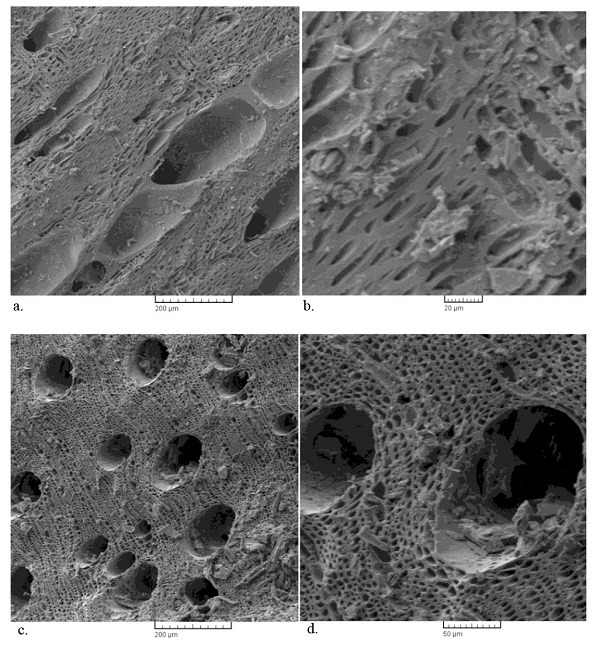
Electron microscopy of cashew wood biochar.
[EXPLAINING THE WATER-HOLDING CAPACITY OF BIOCHAR BY SCANNING ELECTRON MICROSCOPE IMAGES, Gondim et al.https://www.redalyc.org/journal/2371/237158245020/html/]
For more information on biochar you can check out these resources:
- A Perspective On Terra Preta & Biochar by Austin Liu of The Local Carbon Network
- Biochar and the Mechanisms of Nutrient Retention and Exchange in the Soil by Austin Liu of The Local Carbon Network
- Soil carbon increased by twice the amount of biochar carbon applied after 6 years: Field evidence of negative priming Blanco‐Canqui, H., Laird, D. A., Heaton, E. A., Rathke, S. J., & Acharya, B. (2020)
Environmental Sustainability... read more
The goal is to shift the way we think about patterns of daily consumption. This means making changes to lifestyle beyond replacing one consumable with another. It means becoming sensitized to what we use and where it comes from. i.e. Gasoline doesn't just come from a pump and disappear into our carbon footprint. Piercing the veil of global commerce and becoming personally invested in the details of our environmental engagements is the first step to dancing the dance of daily life-on-earth more gracefully.
The Smoke Whisperer is designed to work in confluence with resources in the local environment to meet local needs. To start, the gasifier uses biofuels, not fossil fuels. This means that the emitted carbon was already in the fast carbon cycle and would have largely been released into the atmosphere by the plant's eventual decomposition. This is different from oil, coal and other fossil fuels which rapidly release carbon from the slow carbon cycle that took the earth millions of years to sequester.
[For a great walk-through of Earth’s carbon cycle, check out this article by NASA]
Additionally, amending soil with the activated biochar produced from wood gasification can sequester carbon from the atmosphere at a level equal to that of the initial biochar amendment. This is an exciting characteristic that allows the gasification process to integrate holistically with sustainable, organic agricultural practices. For the Smoke Whisperer, this means a lifestyle where energy, mobility, food, and one's air and water quality are all related.
Another consideration is the carbon emissions of new production which can be avoided by retrofiting existing equipment. For example, it can take up to several years of driving before a new electric vehicle sees carbon reduction over a used gasoline vehicle. This is often called the "carbon payback period". Of course, the footprint is greatly reduced if the vehicle is charged with renewable energy. However, with respect to electic vehicles, it is worth considering the environmental effects beyond carbon. Sourcing lithium, nickel, cobalt, manganese, graphite, aluminum, tin, lithium hydroxide, lithium carbonate and other minerals commonly used in modern batteries has serious environmental costs including air and water pollution, water consumption, land degradation, and energy-intensive processing (often using fossil fuels and emitting greenhouse gases.)
Interfacing with the Engine... read more
The Smoke Whisperer gasification system utilizes a range of modern technologies to integrate efficiently with the vehicle's engine. This involves monitoring temperature, pressure, and airflow at various stages of fuel production along with information from vehicle sensors, and then providing the necessary tools to regulate the performance of the gasifier under different driving conditions, including vehicle speed, load, and driving altitude.
To encourage DIY use of the design, the project uses affordable sensors and commonly available automotive parts.
Flow Chart:
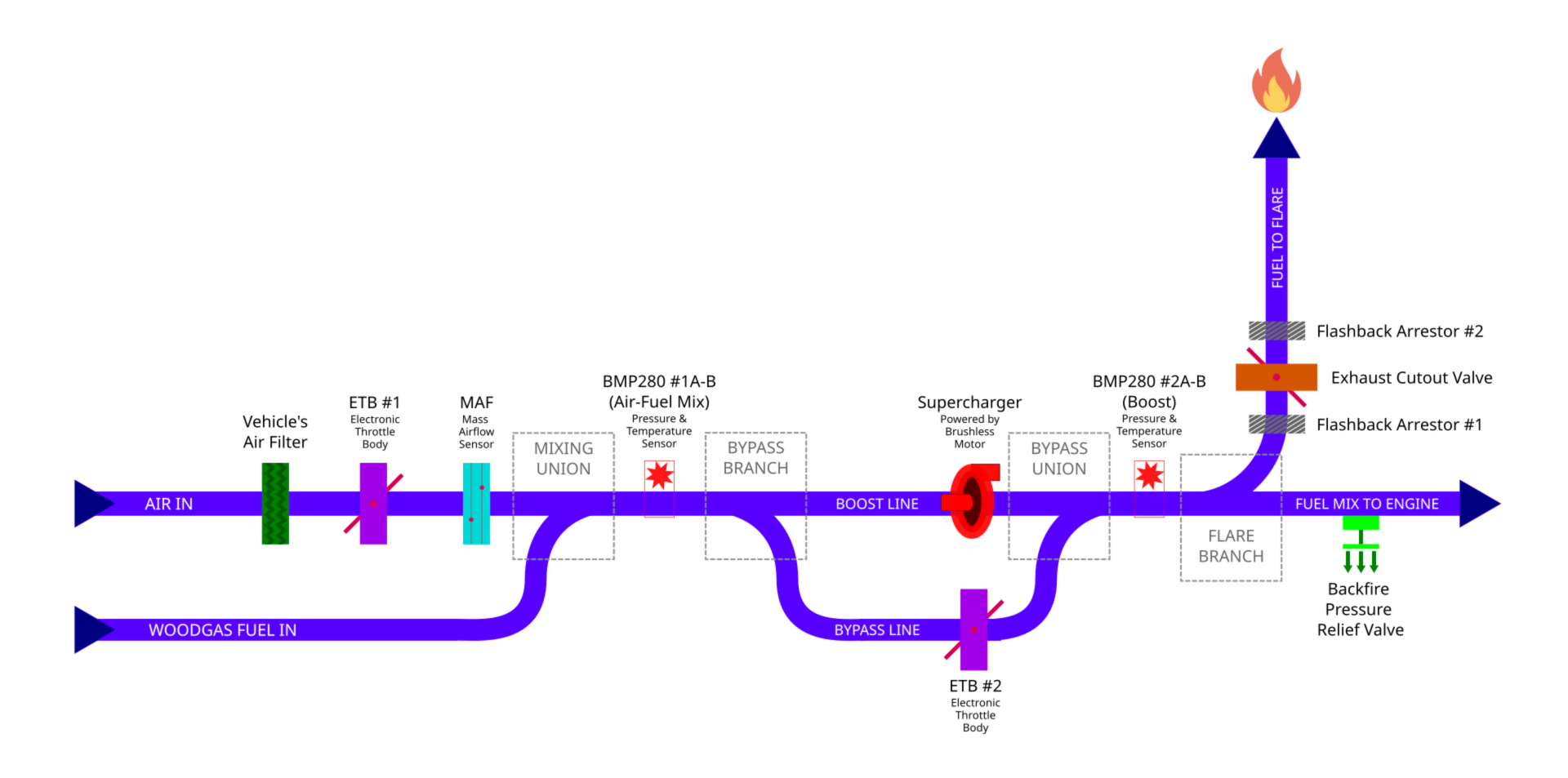
Heat & Hot Water... read more
Gasification produces an abundance of "waste heat". The gas that is produced must be cooled before being used in an engine. As a general rule, the cooler the gas the better the power density.
Through a process of heat exchange, we can both get heat and hot water and cool our gasified fuel at the same time. The heated water can be stored for potable purposes like cooking, cleaning and bathing, or pumped into a subfloor radiant heating system for heat. Using water as an intermediary is an essential step in preventing the possibility of gas leaks into inhabited spaces.
The Smoke Whisperer uses a small heat exchanger that can be mounted outside the vehicle, in-line with the fuel delivery.
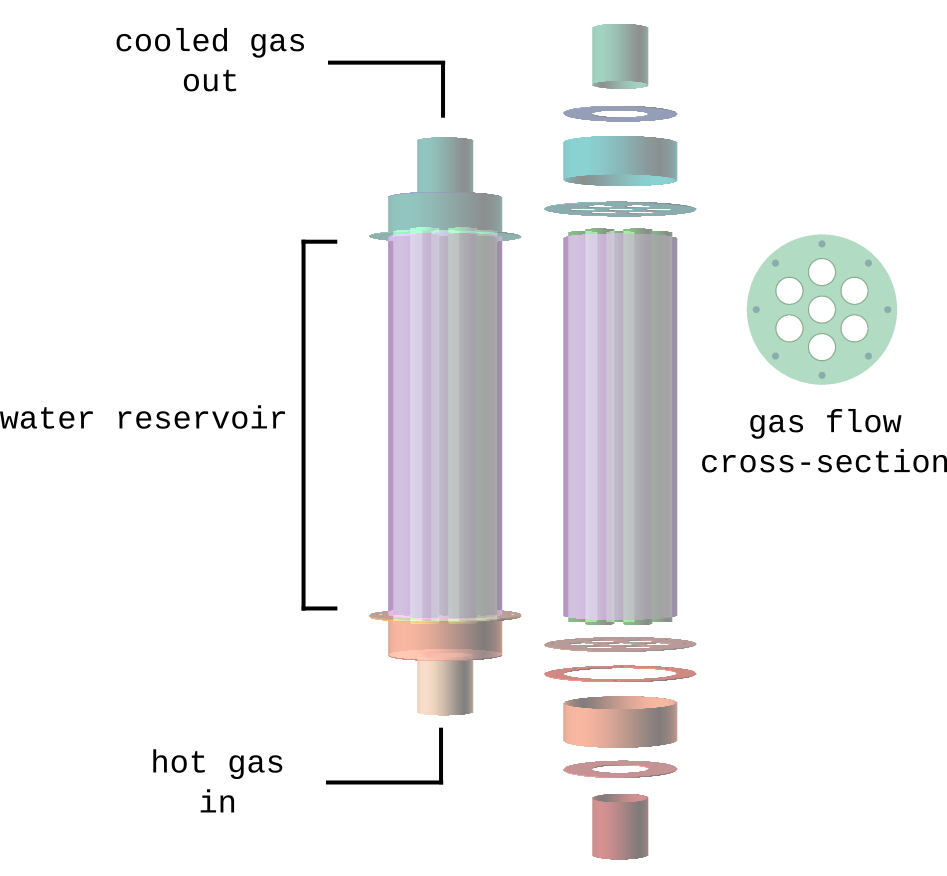
Digital User Interface... read more
The digital interface of Smoke Wisperer is built from Arduino and Teensy microcontrollers. It can be used to monitor and operate the gasifier and its accessories via CAN Bus and SPI. A touchscreen GUI manages both automotive and stationary use modes.
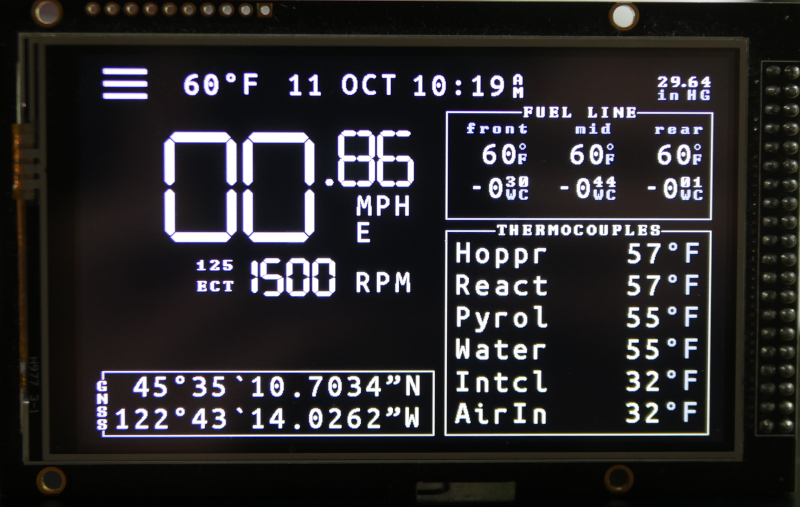

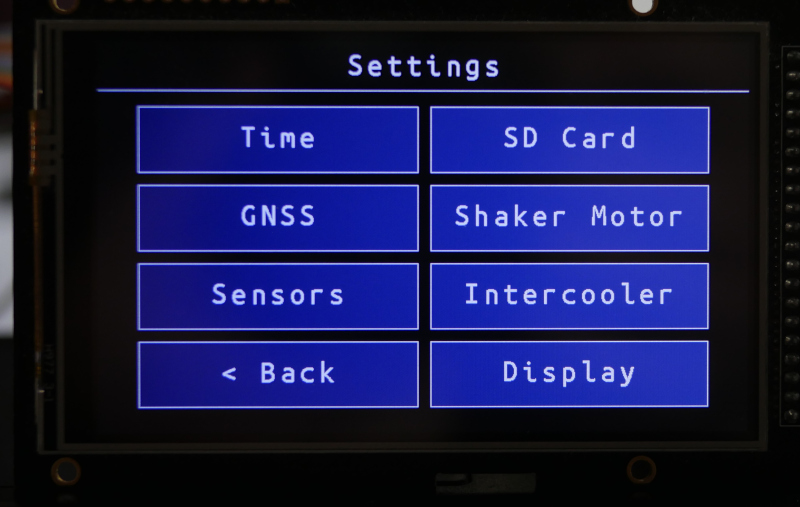
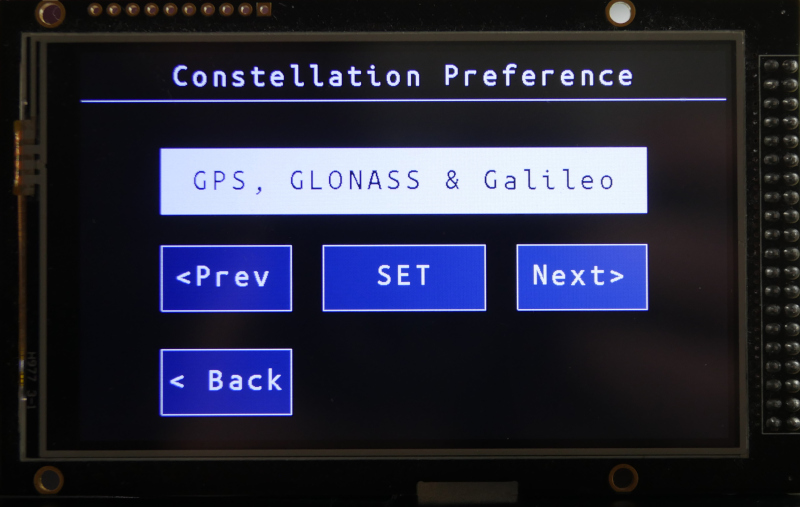
❮
❯
| components | functions |
|---|---|
| Arduino Mega microcontroller + shield | user interface + GNSS |
| 4" inch TFT LCD Display Module | user interface |
| UBLOX SAM-M8Q module | GNSS (GPS, GLONASS, Galileo, Beidou) |
| Teensy 4.1 microcontroller | automotive control module |
| Arduino Uno microcontroller | reading sensor data |
| max31855 thermocouple shields | reading k-type thermocouple data |
| BMP280 | temperature and pressure sensor |
Electricity... read more
Converting the energy that is stored in biofuels into electricity can be done in many ways. A common approach is to simply use the fuel from the gasifier to power a gasoline generator. With the Smoke Whisperer system you can fit an auxiliary line to do just that. That same line could also be used to power other gasoline-fueled internal combustion engines.
Another approach is to use a primary or secondary alternator that is driven by the engine to supply electricity to a battery bank or to devices directly. This allows for passive charging while driving and idling. One issue with this approach, however, is that most alternators only supply 12 volts of direct current, which is a useful but nonetheless limited range. Some crafty tinkerers at Mother Earth News were already working their way around this dilemma in 1985, inviting their readers to "Make Your Own Emergency Power Plant" using their own personal vehicle.
The Smoke Whisperer system will include plans for a modified alternator that can provide both 12 volts DC and 24 volts DC, as well as 120 volts AC. This will allow the system to accommodate a wider range of battery systems, and to power certain AC appliances without the use of an inverter.